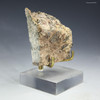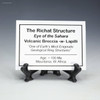Richat Structure Volcanic Breccia Lapilli Mauritania
Brand : Sciencemall-USA
- SKU:
- JPT-84129
- Condition:
- New
- Availability:
- Usually ships in 24 hours.
- Weight:
- 1.00 LBS
- Minimum Purchase:
- 1 unit
- Maximum Purchase:
- 1 unit
- Shipping:
- Calculated at Checkout
Richat Volcanic Breccia with Lapilli from the "Eye of the Sahara"
Visible from orbit yet rarely held in hand, the Richat Structure—commonly called the Eye of the Sahara—is one of Earth’s most enigmatic geologic formations. Spanning over 40 kilometers across, this massive domed uplift exposes ring after ring of eroded sedimentary and igneous layers. At its heart lies something even rarer: volcanic breccia with lapilli, formed during intense hydrothermal alteration. This hand-polished specimen brings that story to your fingertips.
Richat Volcanic Breccia Lapilli Product Details:
- Dimensions: 55mm L × 43mm W × 24mm D
- Weight: 63.4 grams
- Features: One face hand-polished smooth; opposite side left natural
- What's Included: Certificate of Authenticity, tag and tag stand, information about the specimen, and a short paper on "What Remains Unstudied About the Richat Structure and more information about "Why Are Lapilli-Bearing Volcanic Breccias in Alkaline Domes?"
- Note: Sizing cube and display stand shown in photos are not included
What Is the Richat Structure?
While the Richat Structure is no longer thought to be a meteorite crater, questions remain about its explosive core and rare lapilli-bearing breccias — inviting further scientific exploration. Some believe the Richat Structure, with its perfect concentric rings, could be the true site of Atlantis — the lost civilization described by Plato. Though no ruins have ever been found, its scale and symmetry are uncanny.
Richat Rocks for Sale: Location and Identity
- Coordinates: Mauritania, West African Craton
- Diameter: ~40–50 kilometers
- Visual Identity: Concentric, eye-like rings visible from space
- Type: Domal uplift with concentric erosion—not an impact crater
Though once mistaken for a meteorite impact site, the Richat Structure lacks shock features, planar deformation in quartz, or melt sheets—hallmarks of impact craters. Instead, it’s a cryptovolcanic dome, uplifted from deep below by Cretaceous-age magmatic activity.
How did the Rings Form in the Richat Structure?
Stage 1: Stratigraphy Before Uplift
- Flat-lying sedimentary layers: quartzites, limestones, dolomites, sandstones
- Age range: Proterozoic to Ordovician
Stage 2: Cretaceous Intrusion (~100 Ma)
- An alkaline syenitic intrusion pushed upward from below
- Domed and fractured the overlying strata
- Triggered intense hydrothermal circulation
Stage 3: Hydrothermal Alteration
- Silicification and explosive brecciation near the center
- Lapilli tuffs formed from volatile-rich phases
- Silica-rich fluids transformed the surrounding layers
Stage 4: 90+ Million Years of Erosion
- Wind and water sculpted the uplifted dome
- Older, deeper rocks are now exposed at the center
- Younger layers form outward concentric rings
Geological Cross-Section (Simplified)
| Zone | Dominant Rock Types | Description |
|---|---|---|
| Core | Syenite, hydrothermal breccias, lapilli tuffs | Intrusive vent zone; highly altered |
| Inner Rings | Silicified dolomites, quartzites | Fractured and vein-altered rocks |
| Middle Rings | Ordovician sandstones, shales | Tilted and uplifted sedimentary beds |
| Outer Rings | Cambrian to Neoproterozoic sediments | Mostly undisturbed, weathered layers |
Why the Rings Aren’t Symmetrical
- Variation in erosion resistance among layers
- Localized subsidence and uplift variation
- Prevailing wind patterns over geologic time
Why Richat Volcanic Breccia Lapilli Is Scientifically Valuable
This is a lapilli-bearing volcanic breccia from the central uplift of the Richat Structure. Formed during explosive hydrothermal venting, the rock consists of angular clasts, including fused lapilli fragments, all later silicified by mineral-rich fluids.
Lapilli are typically found in arc volcanoes and basaltic fields—but not in deep, intraplate alkaline complexes like Richat. Their existence here expands our understanding of explosive activity in cryptovolcanic systems. Lapilli in an alkaline dome is a rare phenomenon.
Comparable Global Systems
- Pilanesberg Complex (South Africa) – Alkaline ring complex with lapilli zoning
- Mount Kenya – Intrusive ring-dome with explosive debris
- Tassili n’Ajjer (Algeria) – Volcaniclastic remnants in a desert setting
Collectible and Rare
- Few museums or university collections hold labeled Richat lapilli specimens.
- This specimen provides a tangible anchor to a site known mostly from satellite imagery and legend.
- Visually compelling: vesicular texture, fused fragments, silica matrix.
Summary: Why the Richat Has Rings
The Richat Structure is not a crater but a deeply eroded, uplifted dome revealing Earth’s inner layers like pages in a weathered book. Each ring marks a distinct geologic horizon, exposed by time, pressure, and erosion. This lapilli-bearing breccia sample is evidence of its explosive, hydrothermal core—and a testament to the unique processes that shaped one of Earth’s most mysterious formations.
Why Richat Volcanic Lapilli Matters
Don’t miss the opportunity to own a geologic specimen with global recognition but almost zero market presence. This is not just a mineral—it is a conversation piece, a teaching aid, and a literal fragment of a planetary-scale puzzle.
The Perfect Geological Addition for Collections
- Geological and planetary science education
- Collectors of rare or “Earth’s Oddities” specimens
- Discussion of non-crater domal uplift structures
- Display in academic or personal museums
Get your Richat volcanic breccia with lapilli specimen today. Limited Inventory.








![Dallasite pillow breccia Qualicum Beach, Vancouver Island, British Columbia, Canada [11242] shown front on a display stand. Dallasite pillow breccia Qualicum Beach, Vancouver Island, British Columbia, Canada [11242] shown front on a display stand.](https://cdn11.bigcommerce.com/s-ijipkdz2cc/images/stencil/500x659/products/409/3630/Dallasite-pillow-lava-polished-11482__18293.1738630591.jpg?c=1)
